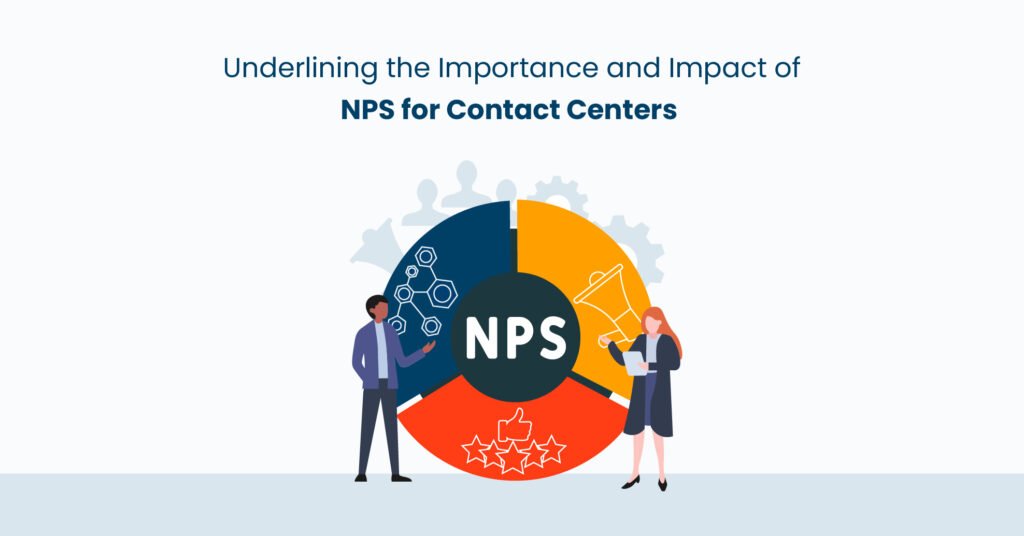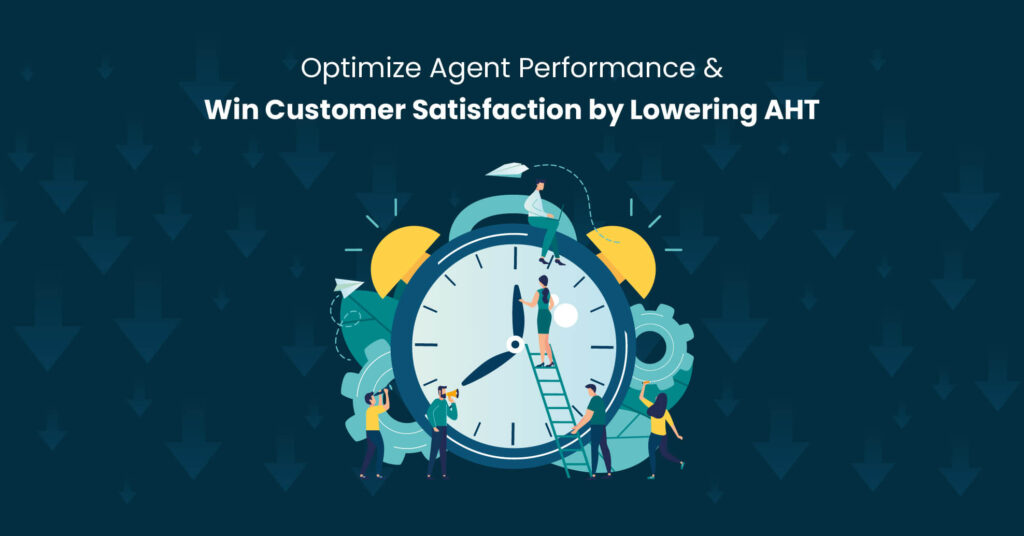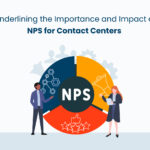
Do your customers love you or hate you?
Do they recommend your contact center to their friends and family?
Do they commend or disparage your ability to deliver great customer experiences?
You can find the answers to these questions with your Net Promoter Score (NPS).
Every contact center aims to boost its revenue and improve its ROI. However, it’s impossible to do either without first providing positive customer experiences. And NPS delivers an effective and data-based approach to determine whether your contact center is successfully meeting these objectives.
What is the Net Promoter Score? How is NPS calculated?
First introduced in a 2003 article in the Harvard Business Review, a contact center’s NPS is often considered a “gold standard” to measure customer experience and determine its ability to garner and maintain customer loyalty.
Two types of NPS can be measured:
- Transactional: Taken immediately after each customer interaction
- Relationship: Taken at regular intervals to assess the ongoing customer-company relationship
NPS is calculated based on a two-part question posed to a customer:
- On a scale of 0 – 10, how likely are you to recommend the company or agent you spoke with to a colleague or friend?
- Why?
In the first part, a score of 0 represents “extremely unlikely to recommend,” and 10 means “extremely likely to recommend.” In the second, optional part of the question, the customer can explain their choice in more detail. Collated scores are then divided into three buckets and the customers are assigned to one of three categories:
| Score | Customer category | Meaning |
| 0-6 | Detractors | Unhappy customers who can damage the brand’s value |
| 7-8 | Passives | Satisfied but unenthusiastic customers |
| 9-10 | Promoters | Loyal and enthusiastic supporters and fans |
To calculate NPS:
- Calculate the total # of survey responses: a
- Find:
- Total # of Detractors: b
- Total # of Passives: c
- Total # of Promoters: d
- Find:
- % of Detractors: [(b)/(a)] x 100
- % of Passives: [(c)/(a)] x 100
- % of Promoters: [(d)/(a)] x 100
- NPS = % of Promoters – % of Detractors
NPS can be anywhere from -100 to 100. In general, a score over 50 is considered good for a contact center, because this indicates that it has more Promoters than Detractors. By measuring NPS, your contact center can understand how well your agents are performing and on which channels you excel.
Equally important, you can identify key sticking points that dissatisfy or annoy customers, understand the strength of your relationships with them, and gain better visibility into their loyalty. This information can help with goal-setting and change management so you can take the necessary actions to improve. In the longer term, NPS can empower your contact center to improve customer relationships, boost revenues and RoI, and enhance its growth potential.
Now that you know why NPS is so important, here are 5 ways to improve it at your contact center.
1. Ask For Qualitative Customer Feedback
A great way to improve customer experiences and thus NPS is to ask customers for feedback. In addition to asking them to rate you on a numerical scale, ask what your agents can do to make their experiences better. What did we do well? Where are we falling behind? Based on their responses to such qualitative questions, you can identify the gaps and decide what you need to improve their experiences. If customers see a tangible improvement in your service, you will notice a steady increase in the number of Promoters as compared to the number of Detractors (or Passives).
2. Reduce Average Handling Times (AHT) and increase First Call Resolution (FCR)
Customers are busy and/or impatient, and they want quick service and fast answers. By reducing AHT and increasing FCR, you can provide quick resolutions, which will make customers happy and yield a high NPS for your contact center. And one of the best ways to do this is to empower your agents with the right tools such as Unified Agent Desktops and integration solutions.
An Agent Desktop provides agents with easy and near-instant access to relevant information and context to focus on customers and has meaningful interactions that improve their experiences. By simplifying agent workflows, the Agent Desktop helps reduce errors, lowers AHT, and improves FCR, all of which positively impact NPS.
Solutions that integrate the contact center’s main operational platform with third-party technologies and tools like CRM (e.g. Salesforce or Microsoft Dynamics), ERP, Zendesk, or ServiceNow can help leverage operational synergies and streamline business processes to improve agent efficiency and productivity, which again has a positive effect on customer interactions, and thus on NPS.
3. Get Rid Of Inefficient Silos
Customers don’t appreciate contact centers where they have to talk to multiple people in different departments to get answers. And this is exactly what happens in siloed contact centers. In such situations, agents often don’t have the proper context crucial to delivering high-quality, timely, and relevant customer service. This adds to customers’ frustration, decreases satisfaction, and increases the probability of negative experiences.
Remove the silos and make intelligent omnichannel routing part of your long-term customer service strategy. With this solution, the caller can be connected to the right agent as soon as they call so they don’t have to be switched back and forth between departments or agents. Also, AI-powered automation, voice agents, and chatbots can help guide more meaningful conversations that improve customer experiences, CSAT, and ultimately, NPS.
4. Identify NPS “Champions” to Help Create an “NPS Culture.”
Identify agents with consistently high NPS numbers, and make them the ambassadors to train and mentor other agents, particularly those with low NPS scores. This can help increase the right knowledge and skills across the enterprise, lift all agents’ performance, and improve the contact center’s NPS.
It can also regularly review customer NPS feedback to identify underperforming agents and deliver the necessary training to plug gaps in their service delivery. Track and display real-time NPS metrics with wallboards, say, by customer segment, channel, journey type, etc. to encourage immediate follow-ups to improve poor NPS experiences.
5. Implement a Balanced Metrics Strategy
Keep in mind that although NPS is an important indicator of customer experiences, satisfaction, and loyalty, your contact center’s customer experience strategy should not be built around it alone. So instead of leveraging NPS in isolation, use it in conjunction with comprehensive call center reporting tools. Implement a balanced metrics strategy that includes other measurements such as Voice of Customer (VoC) and Customer Satisfaction. These measurements can be gathered via a survey immediately after a call to review the agent’s performance and the customer’s overall experience with the interaction. VoC also addresses productivity factors like occupancy, service level, FCR, and even financials like cost per contact.
6. Provide Self-service Options
Most customers want quick resolutions to their queries. Usually, when customers are looking for an answer to a simple question or have too long wait times for representatives, they prefer not to talk to a live agent. Also, the 24X7 availability of an agent is not feasible while warrants customers to look for alternatives. Self-service channels have gained ground over traditional agent-assisted services in recent years. According to a Zendesk survey, 67% of customers prefer self-service to speaking to a support agent.
Self-service allows customers to solve their problems promptly while also improving their knowledge. This allows them the freedom to learn as much or as little as they want to. This can further be extended to offer personalized services to customers for a better understanding and to build brand loyalty, which helps to improve NPS.
7. Measure Customer Feedback
Irrespective of the fact that your NPS scores have been consistently good over time, it’s important to keep a regular check on them. Regular monitoring and measurement are important to keep NPS scores consistent in the long run. Because it’s the continuous improvement of scores that can enable you to witness positive results and keep customer loyalties intact.
The entire essence of NPS lies in the insights gained through surveys which help organizations develop strategies to enhance customer satisfaction. Improving your NPS here means converting your passives and detractors into promoters. For this, it’s important to offer an excellent CX that includes prompt responses, valuing the customer’s feedback, and offering consistent services across multiple touchpoints.
8. Focus on Root Cause Analysis
NPS analysis helps you discover patterns when you compare the feedback of promoters and detractors. For instance, you can identify the unbalanced share of detractors in one team while discovering better scores in the other team. Root-cause analysis can help you make sense of the large swathes of data that help you identify the sub-drivers that contribute to your NPS score.
Such patterns can be especially useful in revealing the reasons that bring down your NPS scores, which could be the product line that the team covers, or whether the fault lies within the department. Targeting the main areas (of customer satisfaction or complaints) that the root-cause analysis reveals, structural changes can be brought about to ensure customer loyalty.
9. Make Structural Changes to See what Works
It won’t be viable for any organization to change their entire site or product just because they received a few complaints. But what if the detractors’ data hints at a structural problem? Then it makes all the sense to implement changes to products and policies, wherever it makes sense.
Tracking the NPS scores and comparing the before and after scenarios can be crucial to determine the success of your policies. This way, if you notice any improvement, there are chances you have earned promoters. Alternatively, if you don’t notice any such improvements, then, sure enough, it’s time for you to go back to the drawing board with the feedback data!
10. Segment Your Customers
The NPS surveys can be useful in breaking down your audience as per their responses and then devising strategies to cater to each one of the categories. The categorization can be on the basis of the products, revenues, services, etc. NPS naturally segments your customers into three main categories: detractors, passives, and promoters. A better base measurement via NPS can help you to improve your value proposition across service experiences to uplift CX.
Valuable insights into these segments can be pivotal to leveraging your NPS data which can help you fine-tune the customer experience by addressing customer queries strategically.
11. Help Customers with Live Engagement
Reducing call handling times and improving first-call resolutions are the center of any strategy that aims to improve the NPS score. It’s nothing out of the ordinary that customers want faster responses to their queries, especially in the fast-paced digital world overwhelmed with competition. If your agents are able to meet customer expectations in faster query resolutions, you are set for a good NPS score. Live engagement tools like Co-Browse and Video chats can come in handy to craft a meticulous strategy for better customer engagement. Such tools allow agents to guide customers in real-time by collaborating with customers until the query is completely resolved.
12. Create KPIs for Drivers of NPS
Interestingly, in order to improve your NPS score, you don’t need to set NPS as the KPI! Rather set and measure other KPIs for important NPS factors. But how would this play out? By driving the customer behavior and not the score itself. The reason is the ease of the agent to focus on and tackle a direct metric, say First Cal Resolution, rather than an indirect metric such as NPS. Imagine telling your staff that they need to improve NPS. they’d end up with the question, “How do I do that?” But if you tell them explicitly that they need to tackle other KPIs like response rate to improve NPS, it becomes much easier. This also sends a clear message to the agents that you care about addressing customer queries efficiently over hitting an arbitrary KPI.
13. Improve your products and services
If your customers aren’t happy with the products and services you offer, they are not likely to stay loyal to your brand. This is despite the umpteen efforts your team might have made in leveraging NPS data to address customer concerns. Good products and services help in developing a positive perception of your brand and set the stage for customer satisfaction itself. Without competent products and services, however, not only does the NPS score not improve but also customer loyalty suffers immensely. So, if you want your customers to be sticking around your brand for the long run, you ought to have competent products and services. This would breed customer loyalty and ultimately snowball into better NPS scores.
14. Set NPS Goals for Each Department
Why do you need to drive NPS for each department? Because that’s how your organization would be judged by the customer. Firstly on the basis of how good your product is and then on the responsiveness of your support team. Thus, measuring NPS at every touchpoint from sales to marketing to after-sales and support becomes vital. This is why every department should have a specific target to achieve in terms of NPS.
By keeping the NPS targets to be specific, measurable, and time-bound, agents can be driven to achieve realistic goals. The challenge here would, however, lie in communicating the actions that need to be taken by each department. Hence, it’s viable to start by prioritizing the journey with the highest impact.
15. Call for Regular Meetings
Planning for NPS targets should follow the top-down approach if it is to permeate every department of your organization. Regular meetings with the involvement of all stakeholders can be effective in affirming everyone’s commitment toward the said objective. Apart from defining realistic NPS goals, these meetings can serve as a much-needed forum for teams to discuss and brainstorm solutions for a better strategy to reach the goal. Secondly, regular meetings can ensure the alignment of the entire organization toward the common objective of improving the NPS score.
16. Understand the Factors that Impact NPS
Before charting out a strategy to improve NPS, it is pivotal to understand the factors that bring down the score in the first place. While the factors are going to be different for every business, it’s always a good practice to identify the factors in the survey that impact your business productivity. For this, your NPS Survey should be designed in a manner that such information can be extracted with ease. For instance, ask your customers the “Would you recommend” question and take suggestions from customers on how to improve.
Analyzing pieces of such information would equip you with all the right information to assess the factors that bring down your NPS score.
17. Use NPS Feedback to Train Agents
Who better guides your agents than the customers themselves? This is how feedback can be utilized efficiently. Such feedback can direct your agents’ energies on the right path, by clearly laying out what they’re looking for and what frustrates them. This culture of change and adaptation needs to be fostered from the top-down level. This would make training agents on metrics, a team effort that is more likely to be successful. Secondly, let your top agents work with other members who have consistently low NPS scores, to help promote quality expertise across the organization, as a collective effort strives to achieve better customer experience.
18. Link NPS to Business Value
The root-cause analysis is likely to bring about a lot of easy wins like making small changes but sometimes tough ones too, like an expensive investment. How to judge the value that this small change would bring to your business? This answer lies in linking business value to your NPS data. For example, compare the revenues of promoters and detractors and then use a retention model to estimate the increased revenue from turning detractors into promoters.
On the flip side, if you can’t demonstrate the value a particular change brings about, it is less likely to be approved. This makes linking vale and NPS data a requisite to implement the changes that your root cause analysis suggests.
19. Link NPS to Business Value
Finally, you should clearly communicate to your agents that there is no perfect score to be achieved. But they should always be striving to prevent the score from declining. This is to say that your team should solely be focused on providing the best customer service possible and such quality service would ultimately pan out well in terms of NPS scores as well. But, it goes without saying that all levels of your organization should be made aware of the NPS scores while being informed that customer loyalty and brand perceptions are key to excelling in this metric. Further, agent training should be undertaken to improve agents’ performance and spread this knowledge organization-wide.
A Final Word: Improve NPS and Use it Strategically
Whether you focus on transactional or relationship NPS, improving it is not a quick or easy process. For maintaining the health of your contact center, it’s best to measure and review NPS regularly and make consistent adjustments to keep it moving on an upward trajectory. In the middle and long term, you should leverage both NPS and other reporting data to do an in-depth analysis and make any necessary (major) changes that can have the largest impact on customer experiences.
NovelVox has helped hundreds of contact centers improve customer experiences and NPS through world-class tools like unified agent desktops for Cisco, Avaya, Five9, Dialpad and Genesys contact centers, iVision wallboards, scripting tools, and CTI connectors. To know how these tools can help boost your contact center’s NPS, contact an authorized NovelVox representative today.
Was this post useful?

Himanshu Suri
Recent Posts
Sign Up for Newsletters
Subscribe to our free newsletter and get blog updates in your inbox
Categories
- Agent Experience (12)
- Career Blogs (20)
- Contact Center Solutions (68)
- Contact Center Wallboard (15)
- Conversational AI (18)
- CTI Connector (44)
- Customer Experience (57)
- CX Scoop (4)
- Digital Engagement (22)
- Events (2)
- Infographic (6)
- Product Release (4)
- Unified Agent Desktop (29)





































